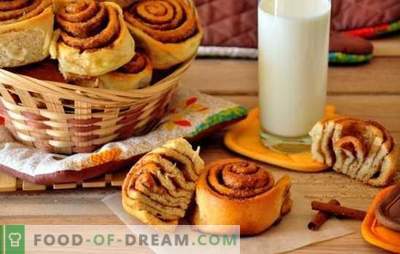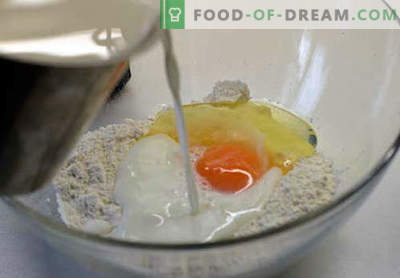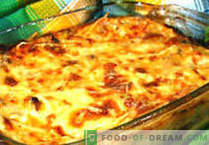
Homemade pastries are always out of competition, and no one will argue with this statement. The attitude to bakery products of our people is special. It happened in the depth of the centuries when Russian cuisine was already famous for pies and loaves, pies, pies, pie, juices, brooms, donuts - no kitchen of the world can boast such abundance. But this is not all. The range of home baking is still actively developing in the Russian folk cuisine, as in the good old days, when the French were in order in the master's kitchen, and as a result, the original traditions and ancient recipes survived only thanks to the Russian peasants, talented national chefs.
Note that even now tea drinking in every home can completely replace lunch. The main thing that tea was served lush and ruddy treat, with the heat of the heat, as we say. Flour, raisins and yeast - thank God, now there is no shortage. Each mistress will have other ingredients for these products, so we turn to the conversation about folk recipes and secrets of yeast dough.
Yeast dough buns with raisins - basic technological principles
The secrets of the yeast dough are not new, but we repeat that even minor details in the preparation of dough are important. Just in case, for example, for beginner housewives we will repeat what the main products for yeast dough should be.
Yeast.
It does not matter what yeast is used, dry or extruded alcohol, be sure to pay attention to the production time, storage conditions and the deadline for when they should be used.
The ratio of dry and pressed yeast is 1: 3. That is, if it is necessary to replace dry yeast with pressed yeast, then we take not ten grams, but thirty, and vice versa. Always check yeast quality before starting work. Dissolve them in a warm liquid, add a spoonful of sugar, intended for the dough, and a few tablespoons of flour, depending on the volume of liquid. Sugar must be added even in the process of making unsweetened dough - it will help “start” the yeast. Flour - food for yeast, and, moreover, its presence in the liquid will help to quickly notice the beginning of fermentation.
At a temperature of 22-30 ° C, a maximum, after 10 minutes, the surface of the prepared liquid should foam. Do not confuse this stage with the preparation of brew. If nothing happens and there are no bubbles on the surface, then there may be two reasons: stale yeast or non-compliance with the temperature regime.
Check everything and eliminate the drawbacks: replace the yeast, or add other liquids to this liquid, check the temperature of the liquid in which the yeast was placed, and the temperature of the room. If water was used for breeding yeast, not milk, it is better to prepare a new mixture, because an excess of yeast in the dough will lead to an unpleasant smell of finished products. Observance of temperature conditions for the effective operation of yeast is a mandatory and important requirement. High temperatures can ruin microorganisms, and too cold liquid, below 18 ° C, will slow down the process; at temperatures below 14 ° C, the yeast will not “wake up”. Before starting work, keep them at room temperature to keep the yeast warm.
Flour
The success of making products from yeast dough largely depends on the quality of the flour. Of course, at home, only experienced housewives can assess its quality, but some secrets, known to great-grandmothers, will help clarify the issue of quality without laboratory research:
• Check the moisture content of the flour: take one handful in your palm and squeeze it hard. Now open the brush and look. If the flour crumbles, it is dry and you will need a little more liquid to make the dough. If the flour breaks into lumps, it means that it is too wet, and the amount of water or milk needs to be reduced accordingly. • The next test is the gluten content - vegetable protein, which, as a result of swelling in a humid environment, forms fibers that hold gas bubbles - the product of the yeast. Take a pinch of flour, from which you are going to bake buns, and, wetting, roll into a ball. The rate at which the dough rises, the pomp and elasticity of the buns depends on how quickly a tight ball forms. If the lump is soft and sticks to the fingers, then, most likely, it will be necessary:
- replace the flour;
- add starch and semolina to flour;
- add more egg yolks to the dough;
- cook choux pastry.
All these techniques help to improve the stickiness of the dough.
Muffin
Everything that is added to the dough, except water, yeast and flour, is called baking. It:
eggs;
milk or dairy products;
fats - vegetable or butter, margarine;
sugar;
aromatic additives - extracts, essences, liquor fillers, cinnamon, vanilla.
Eggs and fats in the dough must be uniquely fresh. Milk can be added in an acidic form - even better: lactic acid bacteria will give the test extra fluffiness.
Pay attention: using sour milk or kefir in yeast dough, or any low-fat dairy products, be sure to add a pinch of soda to the dough, even if the dough is yeast-free. This is done not in order to add volume, but in order to eliminate the sour taste in the finished butter products.
The next important point in the preparation of the dough, which should pay attention to the sweet tooth - adding sugar. Excessive amounts of this ingredient make it difficult to lift the dough. Yeast, being “in a pleasant atmosphere of abundance” will work very lazily, and the dough will rise for a very long time. At high temperature, in the oven, the sugar goes into another state: moisture comes out of it, and solid substances, turning into peculiar threads, will make the crumb in the products hard, tightened, and the baking surface with an excess of sugar will become dry, it will quickly burn. Another secret, about sugar and a little bit - about anatomy, which is never mentioned in culinary articles: taste receptors are located in humans only in the mouth. Therefore, a person feels the sweetness only at the moment when food enters the mouth. Further, after swallowing it, only the amount of carbohydrates consumed matters to the body, and their excess does not add health to the person. Bearing in mind this anatomical feature, a true professional will prepare a dough with a moderate amount of sugar, and the finished baked product will be powdered with icing sugar or coated with icing, jam, chocolate - it will create a sweet taste on the surface of the product.
Depending on the type and assortment of products, raisins and other dried fruits, confectionery poppy seeds, candied fruits, coconut chips, chocolate, jam, nuts are all added to the sweet pastry, everything your heart desires.
Dried fruits are washed, dried and rolled in flour before adding to the dough. Large dried fruits are pre-crushed (prunes, figs, dates, dried apricots). Do I need to steam the raisins before adding to the dough?
Let's reason logically. If the raisins are kept in boiling water, then some of the sugar from it will go into the water, the rest will be “fed up” by the yeast during the proofing of the buns, and at the exit, in the finished buns, only dried fiber will remain from the dried fruit.
If you add raisins in a dry form, not steaming, then it will be, firstly, easier, and therefore will be evenly distributed in the dough, and will not settle on the bottom of the dish;
Secondly, the yeast will not have time to “notice” dry berries, will not wish to eat them, when in a wet dough there is a supply of more “light” sugar;
Thirdly, being inside a wet dough, dry raisins, one way or another, will absorb moisture, and in ready-made, baked products will acquire the necessary moisture.
Conclusion: add raisins without steaming.
There are more secrets for preparing dough than described above, but even following the listed nuances, if you pay attention to them, it is enough for home tea with buns to be always tasty and enjoyable.
1. Buns with raisins from yeast dough - simple baking in a hurry
Ingredients:
Milk 250 ml
Oil (82.5%) 180 g
Eggs 3 pcs.
Kishmish 200g
Sugar 150 g (for the test); 50 g (for powder)
Salt 10 g
Pressed yeast 50 g
Wheat flour (top grade) 650 g
Vegetable oil - for form lubrication
Cooking:
All products must be warm, room temperature. Heat milk to 25-30 ° C. Sift flour. It is desirable to beat the eggs, so that they, too, saturate with oxygen. When whipping, add to the eggs the portion of sugar prepared for the dough. Combine the beaten egg mass with warm milk, diluted yeast, add half the butter, salt and flour. Knead medium density dough. Let go up to a double increase in volume.
Roll out on the prepared work surface in the shape of a rectangle. Lubricate the surface with the remaining oil and sprinkle with prepared raisins: raisins must be bruised, washed and “powdered” with flour.
Roll the rectangular layer into a roll, cut it into pieces of 2 cm. Pinch the cut on one side and place the side with a stuck on the pan, greased with oil, leaving the distance between the products for lifting. Put the baking sheet on the dough, covered with a towel. When the buns rise, brush with a beaten egg and bake for about fifteen minutes at 180 ° C. Removing from the oven, immediately, grease the surface with melted butter and sprinkle with sugar. After 5-10 minutes, transfer to a dish lined with a cotton napkin. Have a nice tea party!
2. Buns with raisins from yeast dough, puff
Ingredients:
Flour 600 g
Sour cream 200 g
Dry yeast 12 g
Salt 10 g
Margarine high-grade 300 g
Vanilla 8 g
Butter, melted 100 g
Raisin 250 g
Powdered sugar 125 g
Cooking:
For the preparation of yeast puff pastry, all products must be cooled. Sift flour, combine with salt and dry yeast. Pour the flour mixture on the table. Frozen margarine chopped in flour, until a homogeneous mass. Put the resulting crumb into a bowl, make a well and pour the sour cream. Knead plastic dough, cover with film and cool in the refrigerator. After half an hour, proceed to rolling and lamination. On the desktop, roll the dough into a rectangular layer, 0.5 cm thick, lubricate its surface with melted but not hot oil, fold it in half, roll it again thinly. This operation must be repeated at least 16 times. The ideal puff pastry has 32 layers. At the last rolling, sprinkle the layer with raisins, fold in half and cut out squares with a side of 2-3 cm. If the dough heats up and starts to stand out while working, put it in the fridge for a while and continue rolling again.
Put the sliced semi-finished products on a baking sheet sprinkled with flour, and place it closer to heat. After proofing, bake at 180 ° C for 10-15 minutes. Powder the cooled puffs through a sieve.
3. Buns with raisins from yeast “Fragrant” dough
Ingredients:
Large orange 1 pc. (100 ml of juice and zest)
Kefir 150 ml
Yeast, instant 8 g
Butter or margarine 220 g
Yolks 5 pcs.
Sugar 150 g
Raisin 200 g
Cognac 50 ml
Vanilla extract 5 mg
Salt 11 g
Flour 650 g
To decorate:
Powdered sugar, coconut flakes - for powder
Syrup 50 ml
Cooking:
For the yeast dough, only yolks will be needed, so separate the whites, and pour them into a clean dish - we will return to them after the buns.
Remove the zest from the orange and squeeze the juice. Put yolks, soft butter, and sugar into the bowl of the combine. Beat this mixture and add all other ingredients except flour. Beat the liquid portion of the dough for about a minute at high speed. Change the nozzles, setting, instead of the whisk, the hook for kneading dough, and add the sifted flour to the bowl. Put the finished dough on a work surface, divide it into pieces weighing 120 g, roll the balls, and put it on a baking tray lined with baking paper. Cover the semi-finished products and place them near the heat source, until the volume doubles.
After baking at 180 ° C. When the top of the buns is lightly browned, remove them for a minute from the oven and brush the surface with syrup. Replace and bake until golden brown.
Warm the buns sprinkled with a mixture of coconut chips and powder.
Beat the remaining proteins into strong foam, adding 100 g of powdered sugar and vanilla at the end of beating. You can combine the vanilla with another flavor or replace to taste. Carefully add nut crumb mixed with flour into the whipped mass, 100 g of nuts and 50 g of flour. Transfer the protein dough into a pastry bag, deposit it on a pan lined with parchment. Bake for 30-40 minutes at 100-110 ° C. After baking, the meringues should be kept for five or six hours so that they are better dried. Then combine the halves with your favorite jam or condensed milk with nuts, or lemon Kurd.
4. Buns with raisins made from yeast dough - “Pletenki” (sponge)
Ingredients for the dough - according to the recipe №1
Working order:
To make the dough, put yeast in the warm milk, 2-3 tablespoons of sugar and a third of the flour prepared for the dough. Mix the mass with a whisk, cover the container with a film and put in heat, at least - for an hour. During this time, the dough will rise by a factor of 2-3, so immediately select deep dishes for the dough.
Beat the butter with the remaining sugar, add the eggs, also beaten into the foam. Add sifted flour to this liquid, having previously combined it with washed and dried raisins and salt. Knead the dough until it begins to easily fall behind the hands and walls of the dish. Leave for proofing for 2-3 hours. During this time it is necessary to knead the dough, at least once, when it doubles in volume.
Grease the hands and the surface of the table with vegetable oil. Roll out the dough into a thin sausage with a diameter of 0.7-0.8 cm. Of the four sausages of the same length (8-10 cm), weave braids and fold them into a ring. Spread semi-finished products on the prepared baking sheet. After proofing, brush with the egg whipped into the foam and bake.
5. Yeast dough buns with raisins: donuts with chocolate icing
Ingredients:
Condensed milk (8.5%) 300 g
Cocoa 100 g
Vanilla powder 6 g
Flour
Salt
Sugar 280 g
Rum essence 5 mg
Eggs 3 pcs.
Raisin 300 g
Milk (3.2%) 350 ml
Yeast instant 8 g
Oil (82.5%) 250 g
Coconut or almond flakes - for powder
Cooking:
For the glaze, separate from the listed ingredients cocoa, 100 g of condensed milk and 100 ml of whole milk, 125 g of butter, 100 g of sugar. Combine all ingredients, mix. Put the tank in the water bath and boil until thick. Add vanilla and rum essence to taste at the end of the glaze preparation. In addition, for a glossy shine, 50-70 ml of rum or brandy should be added to the finished glaze. Whisk the chocolate with a whisk until shine appears. Prepare the yeast dough in the bowl of the combine, first combining all the liquid components, and then add the raisins, flour, yeast, salt to them. Withstand the finished dough on the proofing, roll into a layer, 1.5 cm thick. Using two round grooves of different diameters cut rings. Put the semi-finished products on a baking sheet, bake for 10-15 minutes at medium temperature.
After cooling, cover the donuts with icing and sprinkle with coconut chips.
6. Buns with raisins from yeast dough “Viennese”
Ingredients:
Yeast dough, rich 1.2 kg
Egg 1 pc.
Powdered sugar 100 g
Butter, melted 150 g
Raisin 300 g
Cinnamon to taste
Cooking:
Lubricate the surface with vegetable fat. Put the melted yeast dough on the table. Divide into six identical parts. Roll each piece in the shape of a rectangle, very thin, grease with butter, sprinkle with raisins and cinnamon. Roll each rectangle into a roll, stretching it slightly. Connect the workpieces in pairs, with a sharp knife on each of them make cuts along the entire length. Twist the pairs into a bundle, roll them up with a ring, tighten the ends, and place the rings on a greased baking sheet. After proofing, coat the surface of the rings with a beaten egg and bake.
Put the finished products out of the oven, cover with a napkin for a few minutes, then put on a dish and sprinkle with powdered sugar
Yeast Dough Buns with Raisins - Tips & Tricks
Sifting flour enriches it with oxygen, which is very favorable for yeast dough. Therefore, do not be lazy, and sift flour before kneading dough, even if it has already been sifted a couple of days ago.
The proportion of dry and liquid components in the dough should be approximately the same. Try not to increase the amount of flour in order to quickly knead the dough - it will be very tight, it will be bad to rise, and baking will be hard. The longer the kneading, the more elastic and airy the dough, and this ensures pomp and the finished lightness of the buns.























